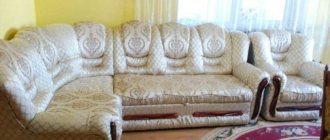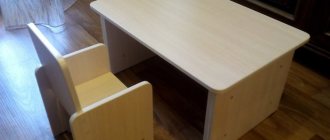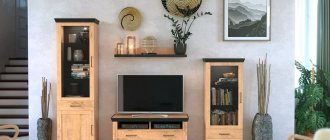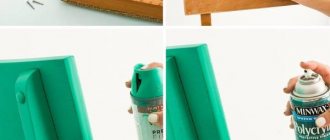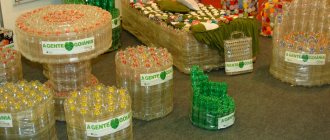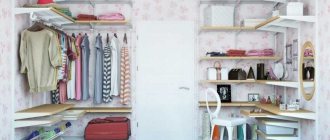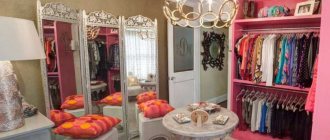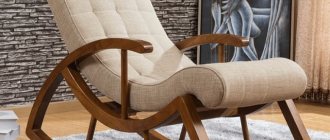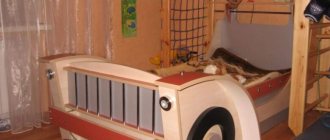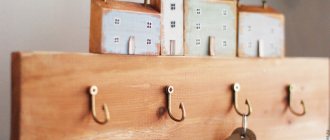Transformation mechanism for the “Tango” sofa
When preparing this article, I came across the fact that manufacturers come up with their own names for mechanisms of the same type in terms of properties. This causes confusion. This is the case with the “Tango” mechanism.
The “Click-clack (clack)” mechanism has similar properties. In fact, both mechanisms are similar to the “Book” already described above.
The main difference from the “Book” is the ability of the “Tango” (“Click-clack (clack)”) to take intermediate positions of the back of the sofa when unfolding.
In addition to full horizontal folding, the backrest can be in a half-lying, half-sitting position. This opportunity creates additional comfort for relaxation.
“Tango” sofas have a section for storing beds
Advantages: the mechanism allows you to fix the back of the sofa in several positions, “Tango” sofas are small in size, and when folded flat, the sofa creates a surface without unevenness or bumps.
Disadvantages: it is not possible to place the sofa tightly against the wall; when transforming, the backrest needs space to fold out.
Stages of assembling upholstered furniture
Purchasing filler
One of the most critical stages in the manufacture of upholstered furniture is the purchase of material, which will directly affect the quality of the final result. For more than 10 years, foam rubber or polyurethane has been used as a filler for the product, the thickness of which completely depends on the place where the material is used.
Choice of upholstery fabric
If you purchase upholstery fabric yourself, you should give preference to the most durable, practical option that meets the following criteria:
- Possibility of self-removal of stains;
- resistance to physical and mechanical stress;
- resistance to household chemicals.
Selection of base material
As the main material of the product, preference should be given to plywood or, in extreme cases, chipboard. All other materials are more fragile and unreliable for the use of such expensive products.
Creating a Sketch
Like any work, the creation of upholstered furniture begins with the development of a sketch, accurate drawings, and setting dimensions.
Creating a sketch is a labor-intensive, important stage, on the result of which almost the entire success of the work done will depend. Since every unaccounted millimeter will emerge during final assembly and upholstery of the structure.
When creating a schematic representation of the planned model, it is necessary to take into account the relevance of the selected assembly mechanisms, if any, ease of use, the modernity of the model, the number of fittings used to ensure the best performance.
Currently, thanks to technological progress, it is possible to create a schematic image in specially developed programs that independently take into account and make adjustments.
Sawing material
Sawing the material can be done in 2 ways:
- independent. Self-sawing is possible when creating the most basic components of a product, using which modern upholstered furniture with your own hands does not require figured cutting, additional large-sized elements, and so on;
- third party. Sawing the material using specialized equipment is performed to create smooth lines, precise cuts, cutting all parts from a large sheet, and so on. The use of specialized equipment to create the basis of modern upholstered furniture is, in some way, the key to proper assembly, and, accordingly, the entire product.
Material marking
After the final cutting of the material, it is necessary to make markings on the components of the product, which will help in the future to avoid the occurrence of curvature, inconsistency, and so on.
Fastening components
Upon completion of the preparatory work, it is necessary to begin the direct assembly of the parts, during which both self-tapping screws and additional fittings are used to ensure the movement of the components of the model.
Attaching foam rubber to the walls of the product
The inner foam rubber is attached to the walls of the product using special glue, which ensures the reliability and durability of the product. Often, it is not worth skimping on purchasing such glue, since additional reworking of the entire product will cost much more.
Fastening of foam rubber is carried out only after direct cutting of the components of the product and fitting. Also, when attaching the foam rubber, it is necessary to ensure softness in all connecting and transitional places. For example, such places could be: joints, side, and so on.
Making a case
Sewing a fabric cover is not always done in the traditional way. Over the past few years, furniture staplers have gained popularity; the quality of fastening staples is no worse than a solid cover.
By creating furniture with your own hands, everyone has the opportunity to test their strength as a designer-developer, process engineer, or assembler of upholstered furniture.
Required Tools
The technology for manufacturing upholstered furniture requires the presence of certain tools:
- drill - this basic tool needed to create holes;
- a screwdriver is necessary for installing furniture fittings, screwing in and unscrewing screws;
- jigsaw – you can’t do without it when cutting and creating various cutouts;
- a grinding machine is needed to clean the surface and level the cut line;
- a tape measure is necessary to take measurements;
- a metal meter ruler is needed to mark the surface;
- caliper - a universal tool for determining thickness and depth;
- a steel square will help align the corners;
- the level will clarify the accuracy of the position of the planes in the vertical and horizontal position;
- a simple pencil - marking lines are drawn with it.
How to make your own furniture from plastic bottles, instructions
Almost all of these tools are in the arsenal of a home craftsman. Furniture production at home does not need more, this will be enough.
Types and classifications of sofas
Under one general name “sofa” are hidden a variety of types of this furniture. And corner ones, and books, and even round ones. To understand which sofa is suitable for an apartment, it is worth understanding the classification of this type of furniture. First of all, let's look at sofas by the type of how they fold out (or transform), that is, by the type of folding structure.
Sofas come in different types of transformation
Table. Types of mechanisms.
| View | Description |
| Sesame | Such a sofa can easily be turned into a full-fledged and quite spacious and comfortable bed, although only for one, and it will have a comfortable mattress resting on an orthopedic hard surface. It is perfect for decorating a nursery, a hall or another room. To unfold this version of the sofa, you first need to pull out the part hidden in its depths, and then raise the sleeping place itself. This is a proprietary development of Anderssen. |
| Junior | This is an excellent option for a small room, often placed in a nursery. It looks like an ordinary sofa, but when unfolded it turns into two beds, one per person. Between the sleeping sections there is a small seating area. This sofa can be folded out very simply - you need to pull out the sleeping places using special hinges. |
| Tango | This sofa resembles a variation of a click-clack book and is suitable for those who want to sleep together. It’s easy to unfold – you just need to lift it up a little and then lower the top back. It turns out to be a fairly spacious place to spend the night. The sofa has armrests, they can be positioned at the desired angle and made into a headrest. |
| Coupe | This sofa can easily be converted into an analogue bunk bed. It is the original development of one of the furniture companies. This is an excellent option for a nursery, as well as for those who often receive guests for several days. To unfold it, you need to lift the upper part of the structure up, fix the side for the upper place, install a ladder and raise the lower sleeping place located in the depths of the bed. |
| Accordion | This is a classic version, which is a kind of accordion of three elements - two halves of the back and seat. By unfolding it, you can get a spacious place that can accommodate up to 3 people. When folded, it will not take up much space, but it requires a lot of free space in front of it. |
| American folding bed | Easily foldable option. The “bed” is rolled up inside, and you just need to unroll it and you can get ready for bed. Moreover, such a place does not have any kinks or seams, which means it is very comfortable to sleep. Ideal for a guest room. |
| Breeze | To unfold such a piece of furniture, you need to roll out the sleeping section forward. It will not take up much space, but will provide sleeping places for two people. |
| New Roller | One of the simplest options. If you pull the back, a dream space rises from the depths of the sofa. There are no rough joints on it, sleeping is very comfortable and cozy. |
| Eurosophist | Easy to fold out comfortable sofa. You just need to pull out the laundry drawer and place part of the seat on top of it. The furniture takes up little space, and the joint between the halves of the sofa is almost invisible. |
| Transformer | Such sofas can be hidden for the day when they are not needed in a closet or table. And only at night take them out again and turn them into a sleeping place. |
Sofa book
Also, sofas can be divided into several types according to the type of design.
- Straight - a sofa with a flat seat and a flat back. Can be folded out. It is this type that book sofas belong to.
- Chair-bed. Compact and take up very little space when folded. Designed for one person's sleep.
- Angular. For a long time, such sofas were very fashionable. But they take up quite a lot of space. They have an angular shape and can be converted into a bed by folding out or pulling out the straight part of the sofa.
- Couch. A small-sized sofa that can easily be converted into a bed for one person just by moving the seat and lifting the lower part.
- Roll-out. This sofa unfolds by rolling part of it forward or to the side.
- Unfolding. To unfold such a sofa, part of it needs to be unfolded.
- Folding - a sofa that can be unfolded and turned into a place to sleep 1-2 people.
Sofa “Book-Finka”
Description of the object
Our business plan for the production of upholstered furniture with calculations is designed to assist in the creation and launch of a small workshop that will produce custom-made products. The most productive use of the document is to organize production in small towns. The enterprise must provide a full technological cycle for the production of upholstered furniture and its sale to consumers.
Main range of products:
- Sofas.
- Banquettes.
- Ottomans.
- Armchairs.
- Sun loungers.
- Chairs.
Surprisingly, there is no definition of “upholstered furniture” in the regulatory and technological documentation. The current standards use concepts such as “sitting furniture” and “lying furniture”. Moreover, these products can be made with both soft and hard elements. Therefore, in the generally accepted understanding, upholstered furniture means products whose design contains traditional elements of “softness”: pillows, springs, various fillings, etc.
How to cover a sofa
For covers it is best to use non-woven material. The simplest option is to cover the modules with fabric with folds at the corners. However, this solution will not last long.
Cases with stitched corners are more reliable. We make it removable with a zipper, ties or buttons, or fasten it with a stapler directly to the frame. We sew at home or order from a master.
First, we divide the sofa into sectors. Keep in mind that after measuring, all pieces of fabric should be cut into rectangular pieces. The rule also applies to sofa elements with other shapes.
Then you need to cut out a blank from wallpaper or newspapers to compare them with the fitted modules. We make cuttings according to them. Don't forget about a seam allowance of 8 cm.
Design features
There are various ideas and drawings on how to make upholstered furniture on your own. To do this, you will need to select the image of the product you like in specialized literature and design it yourself.
It is important to understand that any upholstered furniture consists of the following elements:
- frame made of wood or metal;
- soft filler in the form of foam rubber;
- finishing fabric with sufficient strength and excellent appearance.
When making furniture, all work must be divided into the above stages and gradually achieve the desired result.
When repairing furniture, it is important to decide which element is subject to repair or restoration and deal with it.
Master class on creating a frameless model
This design is lightweight, portable, does not scratch the floor covering, and can be easily repaired if defects occur. For work you will need foam rubber and durable furniture fabric. The manufacturing process begins with drawing up a drawing. First you need to prepare the required materials and tools, namely:
- sewing machine, threads, needles;
- scissors, glue;
- measuring instruments, chalk;
- highly elastic polyurethane foam brand HR 3535, capable of withstanding mattress loads of up to 120 kg;
- flock, zippers.
Let's look at the master class step by step using the example of a folding sofa consisting of 4 pillows:
- From a standard sheet of HR 3535 foam rubber, the dimensions of which are 160x200x4 cm (length, width, height), we cut out the required size, for example, in this case, 160x90x4 is the base, 160x60x4 is the second layer (seat), 160x30x4 is the second layer (stand under the back), 160x50x4 – back. To form pillows for each of these components, you will need 6 sheets to get a sofa height of 50 cm.
- We form pillows from foam rubber, glue the sheets together, and cover them with lining fabric. This will allow them to maintain their shape and will also make them easier to install in the case.
- We sew a cover from flock. To do this, we make markings on the fabric corresponding to the dimensions of the pillows with an allowance of 1 cm, cut it into rectangles and strips, and sew them together. At the junction of the stripes and one of the rectangles we install a zipper.
- At the final stage, all that remains is to assemble all the parts of the sofa together. How the parts will be connected needs to be thought through at the planning stage. There are two main ways to attach elements. They can be sewn inside out, stitching a double strip over the joint.
Stages of self-production
When the drawing is ready, it's time to start manufacturing. It all starts with the frame - the basis of any upholstered furniture. Next, install the base. After this, proceed to the filler. The work ends with the upholstery.
Creating the frame and parts
To make a frame, its base is marked and cut out. This is done in accordance with the drawing using a jigsaw. If the structure is large, then the base is divided into parts that are processed separately. The frame base is a rectangular fragment. If it is made from separate parts, then they all must be carefully adjusted.
Next, vertical posts and horizontal partitions are cut. They are collected in a box. For reliability, notches are cut out at the base of the parts to form couplings - tenon grooves. Then the parts are sanded and covered with stain. It will help protect the frame from negative external influences. The dried frame elements are additionally connected with metal corners.
Installing the base
A base, which is a rectangular sheet, is placed on the prepared box. It is glued to the frame with wood glue or screwed with self-tapping screws. The fasteners should be recessed into the thickness of the material, making special holes for self-tapping screws. This will help avoid tissue damage in the future.
The presence of wooden slats is a necessary condition in the production of orthopedic furniture. These are elastic strips that are fixed to the frame instead of a rigid base. This design helps distribute the load during sleep. The planks are made from steamed wood. They are attached to the frame using metal brackets. Possible fastening with rubber or plastic rivets. With slats you can assemble a more comfortable and high-quality sofa.
Types of furniture staplers, their features and scope of application
Creating an Inner Layer
The optimal seat thickness is 100 mm. It is made from two types of foam rubber - 40 mm and 20 mm. You will need 2 cuts 40 mm thick and one 20 mm thick. The foam rubber is cut out in accordance with the base drawing. One layer is placed on top of the other and glued. At home, Titanium polystyrene foam glue is used. To save money, the middle layer can be laid out with scraps. But there should be a whole foam rubber on the base and at the top.
For greater comfort, the sofa is made multi-layered. The main layer remains foam rubber. For softness, a top layer of padding polyester is added before upholstery. This material also performs an aesthetic function. It helps to round corners and gives the desired shape. To prevent the seat from collapsing under load, layers of foam rubber are padded with felt.
Fabric covering
The sofa is reupholstered with fabric in the following order:
- The upholstery parts are cut out in accordance with the drawing. Before cutting, their contours are applied to the fabric using soap or tailor's chalk. Along the perimeter of the part, add 5 cm per hem.
- The upholstery parts are placed on the parts of the sofa intended for them, straightened out and secured with a stapler. During operation, the fabric stretches well. Loose upholstery will quickly become unusable.
- Particular attention is paid to corners. To prevent them from rounding, the fabric is carefully placed inside. If possible, it is better to stitch the corners. This will help maintain its shape for a long time.
The main thing in upholstering a sofa is care and good tension. If the question arises of how to update a sofa, then new upholstery parts are cut out from the old panels. Sofa covers are sewn using the same principle.
Corner sofa
Corner design
To make a corner sofa, it is not necessary to use complex joints, for example, tenon products, or expensive materials. For work, we suggest using the following material, the volume and quantity of which depends on the size:
- timber 30×50 mm;
- chipboard;
- Fiberboard;
- plywood, thickness 5 and 15 mm;
- self-tapping screws and wood screws;
- nails;
- synthetic winterizer, with a density of 140–170 g/day;
- batting;
- foam rubber, thickness 20 and 40 mm with a density of at least 30 kg/m3;
- glue for foam rubber and wood glue;
- foam crumbs;
- furniture fabric;
- lifting mechanism;
- furniture legs 5 cm high.
As for the tool, for work you will need:
- wood hacksaw;
- miter box;
- screwdriver;
- stapler;
- sewing machine;
- knife.
Configurations and sizes of corner sofa blocks
Each structural block is made of a frame, which is based on timber, chipboard and plywood. The internal space in blocks 1 and 2 can be used rationally by making removable covers. To support them, a 20x30 mm beam is fixed around the perimeter of the frame. It is installed below the top cut to the thickness of the cover plate. To make it easier to lift the lid, you can drill holes in it for your fingers.
Frame design block 1
Blocks 1 and 2 are identical in design. The only difference is their size. The first block is 100x60 cm in size, and the second is 60x60. It is the second block that will be located in the corner of the structure and connect the first and third blocks. As for the third block, you can make a drawer-seat in it. Due to this, the usable area of the sofa will increase. To do this, you can install a retractable or rotating mechanism.
The drawer will also be equipped with a chipboard lid. While assembling it is not difficult, difficulties may arise when making the legs. Why? When sliding the drawer into the body of the sofa, they will interfere. Therefore, instead of legs, it is necessary to increase the height of the front side of the drawer. When unfolding the corner sofa, it will serve as a support platform. To make the drawer easy to pull out, you can attach furniture wheels to the bottom.
Block 3
The cover for the third block (indicated in the diagram) can also be made removable. For example, you can fold bed linen inside.
The size of the seat cushion should be equal to the size of the drawer. Therefore, when the drawer is pulled out, the pillow is removed from the back and placed on it instead of the mattress.
Design of the backrest of a corner sofa
Now it's time to make the backrest for the corner sofa. The manufacturing process looks like this:
- Place 3 beams horizontally and, as in the illustration, connect them with vertical posts. The height of the back in our case will be 105 cm.
- The lower second beam will be located at a height of 25 cm. They will serve to fix the backrest to the sofa.
- The top beam will be used as the basis for fastening the sheathing and provide the necessary rigidity of the structure.
- The frame is sheathed on both sides with plywood 5 mm thick.
- To avoid snags and unevenness when laying upholstery fabric, sand all corners with sandpaper.
- Glue thin foam rubber onto the side and front surfaces, due to this the upholstery will be soft.
Finally, all that remains is to cover the entire sofa, including the backs, with the selected material.
Fastening the upholstery
Before doing this, take all the measurements, and then cut out the fabric with an allowance for the hem. You can fasten the material with a stapler. The mounting location should be on the invisible part of the panel end. Make sure that the fabric does not wrinkle at the corners. As for the manufacture of pillows for the back and seat, they can be made from foam rubber with a density of 140–170 g/day and a thickness of at least 10 cm. You will also need to sew a cover with a zipper. This will allow you to remove the cover and wash it if necessary.
How are sofas made?
USEFUL! Becoming slim has become very easy. “HOUSE 2” For the sake of returning to the project, I lost 25 kg! … Read more here
Today, making sofas attracts many entrepreneurs. Large, medium and small businesses are rapidly developing in this direction. How does the manufacturing process work?
What is the sofa made of?
All sofas have the same components:
- the base or frame is the main structural element on which all components are attached. This is the basis for attaching all parts and shaping the appearance of the furniture.
- spring blocks or soft filler; transformation mechanism;
- upholstery fabric.
In the carpentry shop
In the carpentry shop, plywood or boards are cut, which are then assembled into the frame of the future product. Procurement operations can be divided into several stages:
- cut to length on a cross-cutting machine,
- cut to width on a circular saw,
- grinding the resulting part on a four-sided machine,
- cutting out tenons and lugs with a tenoning machine,
- if necessary, hand-held power tools are used to cut out internal parts from fiberboard or chipboard,
- fastening of the transformation mechanism,
- frame assembly.
Upholstery shop
The assembled frame is sent to the upholstery shop, where a non-woven material (darnit) is glued onto it, which prevents knocking and squeaking during operation. Then they cover it with foam rubber and shoot the upholstery material on top.
The next stage is the installation of soft elements or spring blocks that perform an orthopedic function. The springs are attached evenly along the entire perimeter of the base, as well as in the central part.
On top, on the springs, a dense woven material is glued, which prevents abrasion of the cushioning material, which will be laid in the next layer. Spangon or coconut coir is used as cushioning material. Foam rubber with a height of 40 mm is laid on top, and a layer of padding polyester is placed on the foam rubber.
Please note that to prevent contact with hard parts of the frame, thick foam rubber is glued around the perimeter.
Sewing factory
In this form, glued on all sides, the product enters the sewing workshop.
Self-respecting entrepreneurs use equipment that can most easily handle any type of finishing fabric - from genuine leather to fur.
Here the fabric for upholstery is cut, which is subsequently attached to the finished frame. In the same sewing workshop, covers are sewn, which are then placed on a frame with soft filling.
The production of corner sofas or upholstered furniture of other shapes follows the same principle, with the addition of some processes and components.
After completion of registration and control assembly, the product is packaged in cardboard, film or polyethylene and sent to the warehouse.
USEFUL! Becoming slim has become very easy. “HOUSE 2” For the sake of returning to the project, I lost 25 kg! … Read more here
Individual approach
Today, many manufacturers of upholstered furniture offer their customers a very convenient service - individual production of a sofa according to the customer’s size. What could be better and more convenient than choosing the model you like in the showroom and ordering it from the manufacturer. This method allows you to furnish upholstered furniture even in rooms of non-standard sizes and irregular shapes.
Self-production
Many people think that the large assortment of furniture in stores has completely discouraged craftsmen from making a sofa with their own hands. After reviewing a huge number of forums and talking with experts, we got an unexpected result.
There are no fewer people wanting to make furniture with their own hands; moreover, their number has increased several times.
Availability of materials, a huge selection of fillings, upholstery fabrics, modern high-quality tools and a lot of information - all these factors stimulate craftsmen.
The benefits of making furniture yourself
- Saving money.
Using even the best and highest quality materials, the cost of the product will be lower than the price of a similar product in a furniture showroom.
The surest way to make a quality product is to make it yourself. The ability to manufacture a model to your liking, which will better meet the necessary requirements. Besides, who doesn’t want to make furniture with their own hands, place it in their home and be proud of the result of their labor for many years!
Source: https://odivanah.ru/luchshee/kak-izgotavlivayutsya-divany.html
We create furniture upholstery
Palette for choosing materials for upholstery
Before you start upholstering furniture, you need to decide on the material - leather or fabric. Financial capabilities also influence the choice. You should not choose leatherette - it will not last long. Remember the rules: furniture elements must be covered with fabric before you begin to assemble the structure; when cutting, you need to take into account hem allowances (about two centimeters); Before you start cutting the material, make blanks.
Drawing of a frameless sofa chair for self-production
Having made the necessary measurements, we calculate the required length and width of the material. To make the upholstery last a long time, choose dense fabrics - chenille, tapestry, jacquard. They are better suited for work. We lay out the blanks on the selected material, outline them with chalk, not forgetting about the allowances, and cut them out. In this way we make patterns for the back, armrests, and back wall. We sew it on a sewing machine and put it on furniture elements, then we assemble the entire structure. Cushions on the sofa are sewn in the same way.
Elements of cut parts for upholstery of furniture
Making upholstered furniture with your own hands
Making upholstered furniture with your own hands is an interesting business, and with the necessary knowledge, imagination and, most importantly, desire, you can make not just ordinary upholstered furniture, but downright exclusive things. The first step is to prepare all the necessary materials.
It is clear that upholstered furniture has a wooden or metal frame, which, like a skeleton, is wrapped in soft upholstery. You need filler and a stylish, face fabric. It is better, of course, to start small, for example with original ottomans. Then a chair, an armchair, a sofa. Making upholstered furniture is more difficult than cabinet furniture.
Upholstered furniture can consist of up to 80% cabinet furniture. This is usually a frame. But we are not looking for difficult ways. Modern technologies allow us to make an affordable choice in the direction of furniture production. High-quality foam rubber, a machine for cutting parts from foam rubber, flexible MDF sheets and elastic furniture glue.
Everything you need to start a profitable and enjoyable business. Moreover, your imagination is very important. For a business idea to come to life, your furniture must be in demand. Originality, exclusivity, uniqueness, practicality, beauty and quality are the main rules for the victory of your competitors.
Follow these rules and you will always have your own buyer. You will have your own home factory for the production of upholstered furniture. Moreover, technology allows us to maintain all points at a high level.
We make the frame for upholstered furniture ourselves
When making upholstered furniture with your own hands, part of the work is done according to the principle of making cabinet furniture. We will make the frame with exclusive shapes. For this we use a new furniture material – flexible MDF. This is a very convenient material; it can be effectively used in making furniture with your own hands. Using flexible MDF sheets, you can create curved shapes of any complexity.
The structure of flexible MDF sheets consists of a flexible base of several millimeters and stiffening ribs, which are responsible for the strength of the material and prevent the sheets from bending in cross section. Several sheets are glued together, as a result of which the bent shape of the rigid frame is fixed. The glue must be selected specially for flexible MDF sheets. Technology has its drawbacks.
Try to avoid connections using screws as much as possible. Moreover, modern adhesives allow you to firmly connect wood. It is also advisable to use paints and varnishes to cover the surface. Model an exclusive furniture design on the computer, break it down into separate parts, and print out the forms that you will use to bend the frame.
It all depends on your imagination, but look at the pictures for inspiration.
Exclusive soft part is cut from furniture foam rubber
The upholstered part of the furniture should be made from high-quality foam rubber parts. High-quality foam rubber does not lose its shape for more than ten years. Its structure consists of very small bubbles. The foam is good when compressed, it should just shoot back to return to its natural shape. To adjust the softness, you should adjust layers of different hardness.
This technique is called a sandwich. Different layers of foam rubber with different hardness are selected to achieve the desired effect. In some cases, you can add a layer of felt. The result is often very impressive. When a client sits on a sofa or chair, he feels that the furniture was made with soul, for comfort.
To cut out parts from foam rubber, you can use a figure cutting machine (foam rubber, foam plastic) thermal plotter ChSFR-3D-12.12.22SL. This budget model costs only $2500. The capabilities of this machine are quite sufficient for the most unusual forms of upholstered furniture. When you have the frame and foam blocks ready, you put everything together and make the upholstery.
Fabric upholstery is primarily an advertisement for your furniture product. It should be stylish, beautiful, made of quality material.
Make furniture from high quality materials
It is important to remember that there is no room for savings here. After all, the quality of materials is directly related to the quality of the furniture products themselves and their service life. A beautiful presentation is required. After all, aesthetics in making upholstered furniture with your own hands is extremely important, even paramount.
You need attractive high-quality fabric and the best quality filling. It is clear that for upholstered furniture the filler should not be hard, and it should not be too soft. Another point: the density of the filler varies for individual parts. For example, the highest density for seats and backrests.
Then come the density of the mattresses and armrests. Returning to the topic of upholstery in the manufacture of furniture accessories, it should be understood that it must be both durable, not dry for a long time, not change color (do not fade), not deform (the same applies to upholstery), and at the same time have these characteristics.
Upholstered furniture should be extremely easy to clean and keep clean. Upholstery fabric should be easy to clean or wash (thank God, there are enough different household appliances and household chemicals to care for upholstered furniture). Strength is also important so that the fabric does not develop holes or ripples after covering.
For beginner upholstered furniture makers, experts recommend using dark upholstery fabric at first to simplify tasks.
Why is it important to choose the right sofa transformation mechanism?
- The mechanism is one of the main structural components of the sofa, therefore the overall service life of the transformable sofa depends on its reliability.
- The mechanism affects the convenience and ease of converting the sofa into different positions.
- Depending on the transformation mechanism, different free spaces in the room will be required to bring the sofa into the desired positions.
- The shape of the sofa also depends on the type of transformation mechanism. After all, it is under it that the mechanism is hidden from our eyes.
Now let's get down to specifics. Next, I will present various mechanisms for transforming sofas and describe their positive and negative sides. Let's go!
DIY corner sofa for the kitchen
The standard set of furniture for arranging a dining area includes a table, a corner sofa and stools.
According to the step-by-step instructions, to make a corner sofa for the kitchen, you will need:
- Board made of birch, beech or pine 2 by 4 cm - 100 cm.
- Beam with a section of 4 by 4 cm, about 135 cm.
- The beam is 2.5 by 2.4 cm, about 365 cm.
- Beam 1.5 by 1.5 cm thick - 300 cm. For covering the back wall, a sheet of fiberboard.
- Plywood 0.8 - 1 cm thick for the bottom and sides.
- You also need 5 cm thick foam rubber or padding polyester.
- Upholstery fabric (microfiber, tapestry, leather, nubuck and others).
To make a corner sofa for the kitchen with your own hands, prepare:
- jigsaw
- carpenter's corner
- plane
- furniture stapler
- screwdriver
- Sander
- drill
- bit
- hacksaw
- pliers
- roulette
- hammer
You will also need: confirmations, screws 0.4 by 2 cm, 0.4 by 6 cm and 0.4 by 8 cm, bolts and 0.8 cm washers, dowels, legs, hinges. If you plan to make a folding sofa with your own hands, then according to the instructions, you need a special mechanism. The drawing of the sofa for the kitchen should indicate the calculated dimensions and dimensions. In this case, your kitchen corner will fit perfectly into the dimensions of the room.
The workpieces are sanded and leveled, and only then can they be marked and sawed. The average length of a corner sofa is 120 by 90 cm, the corner insert is 45 by 45 cm, and the back height is 85.5 cm.
First, according to the drawings, the main parts of the sofa from the kitchen corner are made - these are the sides. They are made from a thick sheet of plywood. The markings are made with a pencil, and then the part of the kitchen corner sofa is cut out along the lines with a jigsaw.
The next step is to make two frames from 4 by 4 centimeter beams for both sides of the sofa. Both frames should be in the form of parallelepipeds, which are then fixed to the sidewalls. The connections at the corners should look like a mustache and a spike, which are subsequently glued. The T and L shape connections should be at a 90 degree angle.
At the corners, the connections can be with through holes or hidden, go into half of the beam, and also have one, two, or three tenons. They are secured with dowels or corners with self-tapping screws.
The frame of the corner sofa for the kitchen is connected to the back and secured on the sides. When the base is ready, you can assemble the hinged seat covers. Seats can be solid or sectional.
How to make a wooden shelf with your own hands read more
Rectangular frames for seats are made from a block 2.5 by 2.5 centimeters thick. Then they are sewn up with centimeter plywood. The seats are cleaned and covered with a layer of stain and varnish. Then foam rubber is glued and the fabric is stuffed.
A piano loop is attached to the long part of the corner sofa seats. Fastening the hinged covers is done at the end of the work. The corner module is assembled in the same way. A frame is made from a 4 by 4 centimeter block. The profile should be triangular in shape and have sides at angles of 45 and 90 degrees. The module is covered with plywood.
The assembled two parts of the sofas and the corner module are sanded. Exposed wooden elements are covered with stain and, accordingly, three layers of varnish on top. All parts are placed on the sofa legs and fastened together. The connection takes place using screws to the frame support. There must be at least 8 legs.
Structural details are adjusted when adjusting the height of the legs. Marks are made in the places of future fastening. Holes for bolts with a diameter of 0.8 centimeters are drilled. Bolts and washers for them should have wide margins. There should be twice as many washers as there are bolts, so that one goes under the bolt and the other goes under the nut.
The upholstery fabric depends on the proximity of the sofa to the stove and sink. The surface should be easy to clean and not exposed to chemicals.
For a small-sized sofa, 5 cm foam rubber is suitable. For a semi-soft corner of a larger size, padding is taken from padding polyester. Foam rubber or padding polyester is glued to the back with glue. The fabric is cut out according to patterns and stapled to the back of the back, as well as at the junction of the back with the seat. The material is stretched and securely fastened at the corners. Then it is fixed around the entire perimeter.
Equipment for the production of sofas (prices and brands)
To make quality sofas, you will need:
- Woodworking Machine . Mogilev IE 6009A – $284, Belmash Mogilev 2.4 SDML-2400 – $296;
- Edger . Ryobi RTS1800-G table saw – $247, Makita MLT100 table saw – $549, JET-315SP construction circular saw – $627;
- Lathe . Woodworking lathe Caliber STD 450/1000 – $157, lathe SPEC STD-1000 – $174, lathe Caliber STD-400 – $247;
- Miter saw . Electric saw BISON ZPTK-210-1500 – $109, Miter saw Metabo KS 216 M – $139, electric miter saw Caliber Master PTE-1500/210PRm – $144;
- Circular saw machine . Proma PKS-315S – $638, Proma PKS-315 – $584;
- Grinding machine . JBOS-5 oscillating spindle sander – $549, JSG-64 belt sander – $219, JDS-12 bead sander – $592, WoodTec 418 four-sided machine – $12,300;
- Milling machine . FS Encore Corvette-83 – $629, GMC ½ 1800 W – $234, Silverline FS 1/2, 2050 W – $152;
- Dryer . Cassette wood dryer "Impulse" - $57, tubeless IR wood dryer - $57;
- Sewing machines . Janome Sew mini Deluxe – $67, Jaguar anime – $87, Janome Juno 513 – $114;
- Pneumatic clamp . Press clamp for gluing wood VP 17-2400 B – $1,951, VP-15/2400 – $1,916, VP-15/2400 (T) – $2,003, VP-15-2400 – $1,916.
Calculation of profit from production
By making one corner sofa according to our video course, you can earn from 13,500 rubles by selling it, for example, on Avito for 30,000 rubles. This is a competitive price, as it is lower than the store price.
If you are a beginner, it will take you about a week to make alone:
- 1 day to buy all materials and accessories according to the list;
- 1 day to saw the parts and assemble the frame from them;
- 1 day to foam the frame elements;
- 4 days to sew the patterns and cover the frames.
By making the second and subsequent sofas, the manufacturing time will be reduced by approximately half. It takes the author of the course about 4 days.
To calculate profit, enter your data and press Enter or Tab. Prices are indicated in rubles, but you can enter prices in your currency.
Upholstered furniture as a business
Recently, purchasing custom-made upholstered furniture based on individual sketches has become increasingly popular. This allows small industries to operate profitably with small output volumes. An individual order is not profitable for large factories, or the cost of such an order will be quite high, so a niche appears for a private manufacturer.
Most of the assembly operations in small production are performed manually, which allows saving on the purchase of expensive and voluminous equipment and its subsequent maintenance.
In a small production it is easier to adapt to new fashion trends and quickly respond to consumer preferences. Changing a model range in mass production is a long and highly costly process, which is why factory upholstered furniture often looks outdated. The technological process in a small production is flexible, which will allow the use of various materials and a wide range of furniture fabrics.
In technical regulations and GOSTs there is no such term as upholstered furniture. There is a classification that divides interior items according to their purpose, for example, for lying or sitting. These include:
- sofas,
- ottomans,
- couches,
- sun loungers,
- armchairs,
- chairs,
- banquettes.
Consumers classify all of the listed pieces of furniture as “upholstered,” although they can be made hard, so there is no such division in the technical documentation.
Mechanism for transforming the sofa “Italian folding bed”
This transformation mechanism belongs to the double-folding mechanisms, just like the American clamshell. A double-folding mechanism is a mechanism that is brought into working position in two steps.
The principle of operation of the mechanism
To unfold the Italian folding bed from the sofa to the bed, you need to pull the upper part of the back of the sofa towards you (usually the back has a special loop for this purpose).
- In the first step of unfolding, the back of the sofa, together with the pillows, tilts forward and then lies down and rests on the seat of the sofa.
- At the second stage, the inner part of the sofa structure rotates around its axis, this is reminiscent of the unwinding of a rolled mattress. After this reversal, the support legs are revealed; the previously hidden ones were hidden and folded inside the structure, and the resulting sleeping area of the sofa rests on them.
Due to reinforced springs, the mechanism can be folded and unfolded without significant effort.
Advantages of the Italian folding bed: this mechanism is the most reliable and durable of folding beds, this became possible thanks to the use of reinforced metal pipes in the frame of the mechanism, the sofa when folded has a compact size, when unfolding there is no need to remove the pillows from the seat of the sofa, Italian folding beds have the most a thick and comfortable mattress for sleeping; in addition, the frame uses slats and belts that create an orthopedic effect.
Disadvantages: lack of storage space for linen, high price
In terms of ease of use and orthopedic properties, this type of mechanism is most suitable for a sleeping sofa for daily use.
Soft seat
Let's move on to installing a soft pad on the seat. We cut out a square pillow from a sheet of foam rubber or padding polyester of such dimensions that when placed on the seat it protrudes at the edges by 10-12 mm.
Cut out a square piece from thick fabric. We sew a cover from this material, simply bending and stitching the corners to create a fabric “box” with sides and a bottom. We are guided by the following considerations: the material should cover the foam rubber, the ends of the seat board and bend down onto it by 20-25 mm (see.
).
The fabric is shot with staples
We place a soft pad on the seat, pull on the cover, place its edges from below under the seat and secure it with staples.
The stool is ready. Now it is advisable to make linings of thick rubber on the lower edge of the legs. You can buy suitable fittings at a furniture store.
The soft part itself can be framed along the edge of the seat with plastic edging tape or cord, nailing it with decorative nails.
Give free rein to your imagination, and using this principle you will be able to make the most bizarre and unusual furniture products.
Give free rein to your imagination to make the most unusual furniture
